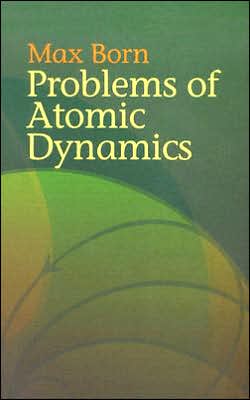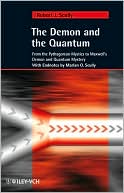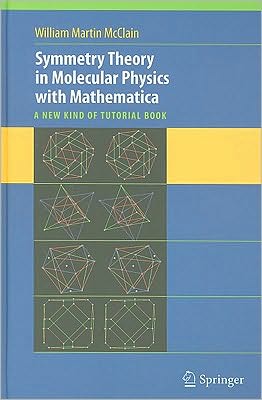Problems of Atomic Dynamics
During 1925 and 1926, the Nobel Laureate gave two sets of lectures at MIT: one on the structure of the atom, the other on the lattice theory of rigid bodies. This volume for upper-level undergraduates and graduate students features the text of both lectures and represents the foundations of quantum theory.
Search in google:
In 1925-26, the late Max Born gave two sets of lectures at M.I.T., one on the structure of the atom, the other on the lattice theory of rigid bodies. Problems of Atomic Dynamics contains the text of both sets.
ForewordviiPrefaceixSeries IThe Structure of the AtomLecture 11Comparison between the classical continuum theory and the quantum theoryChief experimental results on the structure of the atomGeneral principles of the quantum theoryExamplesLecture 212General introduction to mechanicsCanonical equations and canonical transformationsLecture 321The Hamilton-Jacobi partial differential equationAction and angle variablesThe quantum conditionsLecture 425Adiabatic invariantsThe principle of correspondenceLecture 532Degenerate systemsSecular perturbationsThe quantum integralsLecture 638Bohr's theory of the hydrogen atomRelativity effect and fine structureStark and Zeeman effectsLecture 747Attempts towards a theory of the helium atom and reasons for their failureBohr's semi-empirical theory of the structure of higher atomsThe optical electron and the Rydberg-Ritz formula for spectral seriesThe classification of seriesThe main quantum numbers of the alkali atoms in the unexcited stateLecture 854Bohr's principle of successive building of atomsArc and spark spectraX-ray spectraBohr's table of the completed numbers of electrons in the stationary statesLecture 960Sommerfeld's inner quantum numbersAttempts toward their interpretation by means of the atomic angular momentumBreakdown of the classical theoryFormal interpretation of spectral regularitiesStoner's definition of subgroups in the periodic systemPauli's introduction of four quantum numbers for the electronPauli's principle of unequal quantum numbersReport on the development of the formal theoryLecture 1068Introduction to the new quantum theoryRepresentation of a coordinate by a matrixThe elementary rules of matrix calculusLecture 1175The commutation rule and its justification by a correspondence considerationMatrix functions and their differentiation with respect to matrix argumentsLecture 1279The canonical equations of mechanicsProof of the conservation of energy and of the "frequency condition"Canonical transformationsThe analogue of the Hamilton-Jacobi differential equationLecture 1383The example of the harmonic oscillatorPerturbation theoryLecture 1489The meaning of external forces in the quantum theory and corresponding perturbation formulasTheir application to the theory of dispersionLecture 1594Systems of more than one degree of freedomThe commutation rulesThe analogue of the Hamilton-Jacobi theoryDegenerate systemsLecture 1699Conservation of angular momentumAxial symmetrical systems and the quantization of the axial component of angular momentumLecture 17106Free systems as limiting cases of axially symmetrical systemsQuantization of the total angular momentumComparison with the theory of directional quantizationIntensities of the Zeeman components of a spectral lineRemarks on the theory of Zeeman separationLecture 18113Pauli's theory of the hydrogen atomLecture 19119Connection with the theory of Hermitian formsAperiodic motions and continuous spectraLecture 20125Substitution of the matrix calculus by the general operational calculus for improved treatment of aperiodic motionsConcluding remarksSeries IIThe Lattice Theory of Rigid BodiesLecture 1133Classification of crystal propertiesContinuum and lattice theoriesGeometry of latticesLecture 2139Molecular forcesPolarizability of atomsPotential energy and inner forcesHomogeneous displacementsThe conditions of equilibriumExamples of regular latticesLecture 3146Elimination of inner motionsCompressibilityElasticity and Hooke's lawCauchy's relationsDielectric displacement and piezoelectricityResidual-ray frequenciesLecture 4155Ionic latticesKossel's and Lewis' theoryCalculation of the lattice energy according to Madelung and EwaldLecture 5163The energy of the rock-salt latticeRepulsive forcesDerivation of the properties of salt crystals from the properties of inert gasesLecture 6168Experimental determination of the lattice energy by means of cyclic processesThe electron affinity of halogensHeat of dissociation of salt moleculesTheory of molecular structureLecture 7176Chemical crystallographyCoordination latticesHund's theory of lattice typesMolecule, radical and layer latticesLecture 8183Physical mineralogyThe parameters of asymmetrical latticesThe molecule lattice of hydrochloric acidBragg's calculation of the rhombohedral angle of calciteRutile and anataseInfluence of the polarizability on elastic and electric constantsThe breaking stress of rock saltLecture 9189Crystal opticsRefraction and double refractionOptical activityThermodynamicsQuantum theory of specific heatsDistribution of frequencies in phase spaceLecture 10196Thermal expansion and pyroelectricityConcluding remarks








